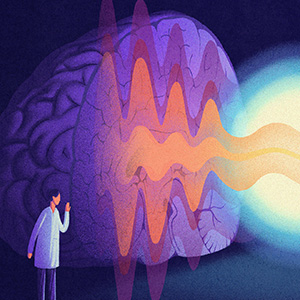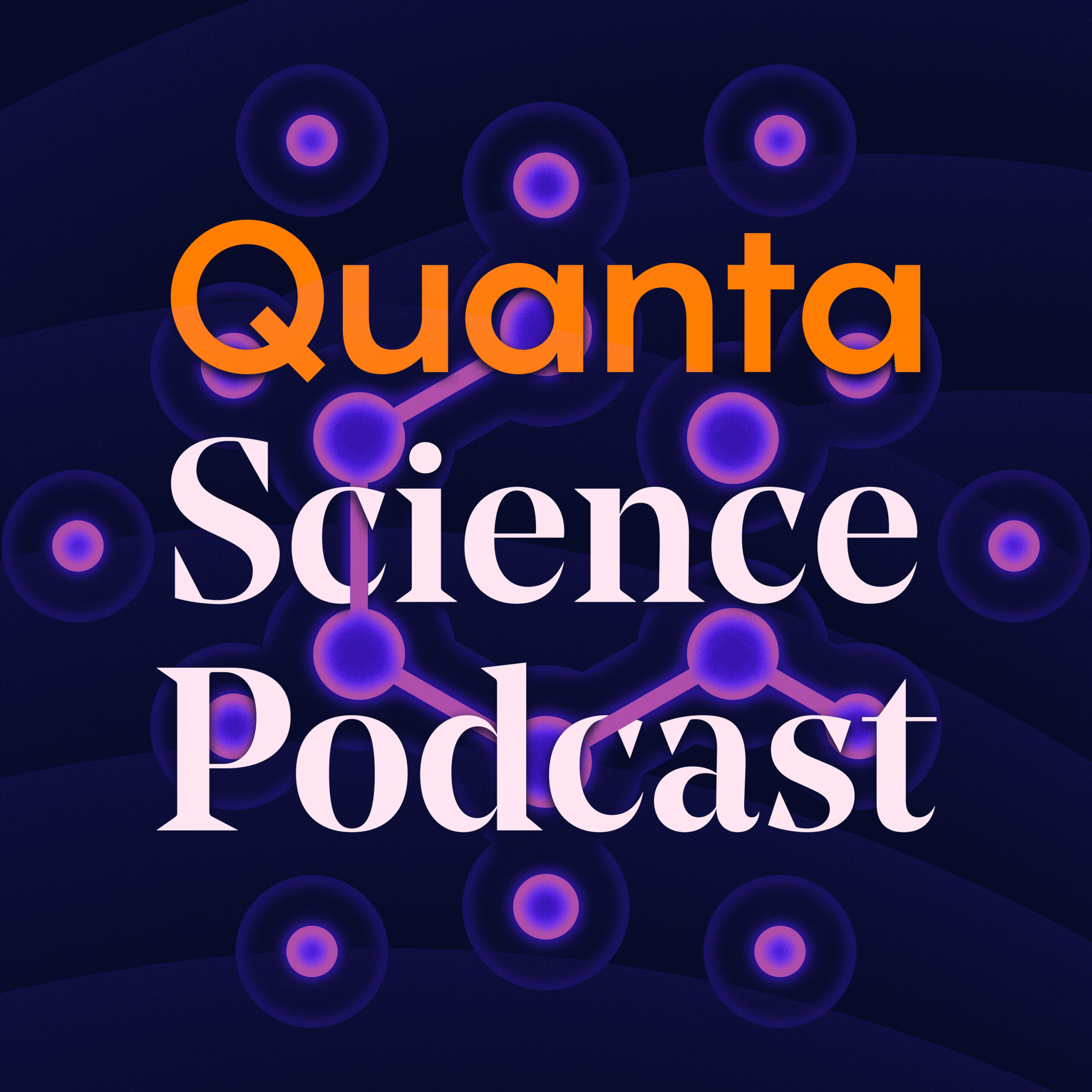
Brain's 'Background Noise' May Explain Value of Shock Therapy

Quanta Science Podcast
Deep Dive
- ECT's effectiveness in treating major depressive disorder (50-70% success rate), exceeding that of medications (10-40%).
- Historical negative perceptions and stigma surrounding ECT due to its past use without consent or regard for patient comfort.
- Modern ECT procedures emphasize patient consent, anesthesia, and muscle relaxants to minimize discomfort.
Shownotes Transcript
Welcome to the Quanta Science Podcast. Each episode, we bring you stories about developments in science and mathematics. I'm Susan Vallett. Electroconvulsive therapy is highly effective in treating major depressive disorder, but no one knows why it works. New research suggests it may restore balance between excitation and inhibition in the brain. That's next.
It's season three of The Joy of Why, and I still have a lot of questions. Like, what is this thing we call time? Why does altruism exist? And where is Jan Eleven? I'm here, astrophysicist and co-host, ready for anything. That's right, I'm bringing in the A-team. So brace yourselves. Get ready to learn. I'm Jan Eleven. I'm Steve Strogatz. And this is... Quantum Magazine's podcast, The Joy of Why. New episodes drop every other Thursday.
Electroconvulsive therapy has a public relations problem. The treatment sends electric currents through the brain to induce a brief seizure. It has barbaric, inhumane connotations. For example, it was portrayed as a sadistic punishment in the film One Flew Over the Cuckoo's Nest. But for patients with depression that does not improve with medications, electroconvulsive therapy, or ECT, can be highly effective.
Studies have found that some 50 to 70 percent of patients with major depressive disorders see their symptoms improve after a course of ECT. In comparison, medications aimed at altering brain chemistry help only 10 to 40 percent of depression patients. Still, even after many decades of use, scientists don't know how ECT alters the brain's underlying biology.
Bradley Wojtek is a neuroscientist at the University of California, San Diego. He remembers talking to some psychiatry colleagues about the treatment. And I asked, as a neuroscientist, well...
How is this working? One of them said, well, you know, we basically think of it as rebooting the brain. And to me, that was just a wild response, right? That like their best answer that they could come up with was it's like rebooting the brain. And I was thinking lots of things reboot the brain. I go to sleep and that kind of reboots the brain. Like why? Why ECT? Like why giving people a seizure?
And so that let us down. It just snowballed from there. Recently, Wojtek and his collaborators paired their research into the brain's electrical patterns with patient data to explore why inducing seizures has antidepressant effects.
In two studies published last fall, the researchers observed that ECT and a related seizure therapy increased the unstructured background noise hiding behind well-defined brain waves. Neuroscientists call this background noise aperiodic activity. The authors suggested that induced seizures might help restore the brain's balance of excitation and inhibition, which could have an overall antidepressant effect.
Sydney Smith is a graduate student in neuroscience in Voytek's lab and the first author of the recent studies. It's so interesting because every time that I talk to someone who's not in this field about this work, they're like, they still do that? They still use electroshock? I thought that was just in horror movies. And I'm like, no, they do. And it's
the most effective way that we treat depression. And so dealing with the stigma around it has become even more of like a motivation to figure out how it works because people are so scared of it. Smith says she understands why people are leery of the treatment. It's been stigmatized, not for no reason, like it's been used in the past.
without patient consent or without really consideration for their comfort. And that's not the way that the treatment is performed anymore at all. It's treated very carefully.
Consent is always given. Patients are given anesthesia and a muscle relaxer to make sure that their bodies do not experience the seizure. They don't have to go through that physical discomfort. About eight years ago, Wojtek teamed up with psychiatrist Maryam Soltani, also at the University of California, San Diego, and her colleagues. They were collecting electroencephalogram data on patients undergoing ECT for diagnosed major depressive disorder.
The researchers attached electrodes to the front of the patient's heads to measure the brain's electrical output before and after ECT treatment. Decades of studies have shown that a healthy brain's electrical output produces patterns of repetitive oscillations, or brainwaves. For example, alpha waves with frequencies of 8 to 12 hertz tend to appear during deep relaxation or sleep.
Previous research that connected alpha waves with depression led Soltani and Wojtek to initially hypothesize that ECT influences alpha waves. If true, that would also help explain why ECT tends to slow certain frequencies in the electroencephalogram output. But a preliminary analysis of the first two patients showed something different: a marked increase in aperiodic activity, or background noise, coming from the brain.
This background noise has been a hot topic for Wojtek's lab in recent years. Alpha waves are orderly, appearing at known frequencies. So rather than focusing on these orderly brain waves, Wojtek studies the disorderly fuzz in between. Although aperiodic activity generates no obvious pattern on an electroencephalogram, his group has developed statistical tools that reveal its underlying structure.
It's this aperiodic structure that the researchers observed in Soltani's ECT patient data. In an initial study of nine patients, published in November of 2023 in Translational Psychiatry, the researchers reported that aperiodic activity increased after ECT.
Then, in an accompanying study, the neuroscientists tackled larger datasets previously collected from 22 patients receiving ECT and 23 patients receiving magnetic seizure therapy, which uses magnetic fields rather than electric currents to induce seizures. These analyses also found that aperiodic activity tended to increase after the therapies.
A-periodic activity is thought to relate to the balance of excitation and inhibition in the brain. When a neuron receives a signal from another neuron, it will be either excited or inhibited, that is, either more or less likely to fire. In 2017, Wojtek and his collaborators published a study in the journal NeuroImage suggesting that A-periodic activity reflects inhibitory processes.
the link between aperiodic activity and inhibition needs more follow-up research. Still, when the researchers put that finding together with their new clinical research, they postulated that the seizure therapies could be inhibiting some groups of neurons, and that inhibition may show up as an increase in aperiodic activity in the electroencephalogram.
The authors speculated that the inhibitory effect in ECT could be associated with a decrease in depression symptoms. Smith and her colleagues wrote in their initial November 2023 study that ECT might make depressive symptoms better by restoring healthy levels of inhibition in frontal cortices. The research team didn't design these experiments to show a connection between aperiodic activity and depression.
K. Ranga Rama Krishnan is senior advisor to the CEO of Rush University System for Health in Chicago. Krishnan spent several decades overseeing a program that included ECT at Duke University, but wasn't involved in the studies. He says it's possible a connection exists between aperiodic activity and depression. But to prove it is a very different game.
That's one of the reasons why we have a lot of theories about how ECT works. Some theories are based on the chemistry of the changes in the brain. Some theories are based on the location of the changes in the brain. And all of these things, I think of it as marking a particular aspect of brain function. But you can't say what is causative. You can say ECT did this.
But to prove that that change is what led to the change in depression requires much, much larger studies. And Krishnan says those studies would have to have a deliberate experimental design. You have to have people who got better, people who didn't get better. You have to show the changes happen at a time frame consistent with when the depression lifts.
So you can imagine the complexity of measuring and designing that. But before you even do that, you have to do what they're doing now. Find out what are the things to look at before you launch big studies to say, could that be one of the ways in which depression is improved by ECT?
It's a step in the right direction of understanding it. Sarah Lissemby is the director of the Non-Invasive Neuromodulation Unit at the National Institute of Mental Health, who wasn't involved in the research. She says another important takeaway is that the electric and magnetic versions of the therapies generated similar shifts in aperiodic activity.
Lisembe says that suggests it's not the electric fields in ECT that relieve symptoms of depression, but rather the induced seizure.
Lissenby's recent research shows that magnetic seizure therapy is as effective as ECT and has fewer and less severe side effects. But while ECT is commonly available in clinical settings, magnetic seizure therapy hasn't been approved by the Food and Drug Administration and is only available in the context of research studies.
Smith and Wojtek envision that if their results hold up in future studies, aperiodic activity could become a metric that someday helps doctors predict which patients would most benefit from these treatments. Here's Wojtek again. ECT is a very crude instrument. It's very blunt. It's a sledgehammer. It's like so imprecise. And the ideal is taking what we've learned in our studies, iterating on them,
see if we can make it a little bit more precise, do another study, iterate, make it more precise. The goal would be to move away from doing DCT. The physicians make it as comfortable for their patients as possible. It is still an incredibly stressful environment and you are still causing somebody to have a seizure on purpose. That is the goal of these treatments. If you could
reduce that, reduce the amount of time they have to have a seizure or the severity. And so the goal is to make it so that you don't have to do these kinds of
Beyond clinical applications, this line of research can help patients understand what happens in brains during ECT and why they might benefit from it. Here's Smith. I hope that some of the benefit of the research that we're doing is so we can more fully understand it. So at least a part of that conversation about the risks and benefits of receiving this treatment can be like, and this is what we're trying to change in your brain that we think is wrong.
And I feel like that's a little bit more tangible than something like a reset button. Arlene Santana helped with this episode. I'm Susan Vallott. For more on this story, read Elizabeth Landau's full article, Brain's Background Noise May Explain Value of Shock Therapy, on our website, quantummagazine.org. Make sure to tell your friends about the Quanta Science Podcast and give us a positive review or follow where you listen. It helps people find this podcast.